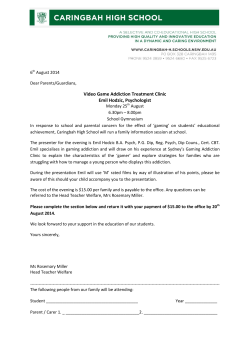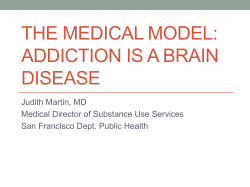
Chapter 9 - Understanding Drugs & Medicines Worksheet
Chapter 9 - Understanding Drugs & Medicines Worksheet Section 1: Drugs Write the letter of the correct answer on the line. 1. A written order from a doctor for a specific medicine is called a(n) a. prescription. b. drug. c. side effect. d. antibiotic. 2. The two origins of all drugs are a. hospitals and pharmacies. b. drug stores and doctors’ offices. c. natural sources and laboratories. d. pharmacies and grocery stores. 3. A method of drug delivery in which the drug is applied directly to certain areas of the body and absorbed into the skin is called a. a transdermal patch. b. an implanted pump. c. inhalation therapy. d. topical application. Answer each question in the space provided. 4. What are the three qualities that make a drug useful as a medicine? Safety, effectiveness, mild side effects 5. What is the distinction between a drug and a medicine? A drug is any substance that causes a change in a person’s physical or psychological state, while a medicine is a drug used to cure, prevent, or treat illness or discomfort 6. How do drugs of abuse differ from medicines? Drugs of abuse are taken for mind-altering effects rather than for a medical purpose. Answer the following questions in the spaces provided. 7. What are the two qualities that a medicine must possess? Safety and effectiveness 8. What distinguishes medicines from drugs of abuse? Any drug that is used to prevent, to cure, or treat illness or discomfort is a medicine. A drug of abuse has mindaltering effects and no medical purpose. 9. Complete the network tree about over-the-counter (OTC) drugs by using the terms from the list below. Some terms are used more than once; others are not used at all. acetaminophen relieves pain temazepam causes sleepiness increases alertness methylphenidate antacids focuses attention in ADHD Section 2: Drugs and Medicines Analyzing Data: Reading a Prescription Label 1 - Patient’s name 2 - Prescription number and dates prescription was filled 3 - Quantity of medicine provided, name and strength of medicine 4 - Instructions for taking medicine 5 - Side-effect warnings 6 - Refill information and expiration date 1. How often should this patient take the medicine? 2 capsules by mouth every 12 hours for ten days 2. When the patient finishes the medicine, will she be able to get a refill? When does the medication expire No refills and it will expire on 02/01/2016 3. What is a possible side effect of this medicine? The medication is not for humans; for veterinarian use only (perhaps a dog or cat) 4. How many days will it take for the person to finish the medicine provided? Ten days 5. Do you think it’s safe for this person to stop taking this medicine once she begins to feel better? It is best to contact the doctor before stopping any medication. Answer the following questions in the space provided. 6. What are two reasons that prescriptions are required for some medicines? Prescription medicines are often powerful and often treat serious illnesses 7. What information does a prescription include? Dose, timing, frequency, and duration 8. What are the steps in the approval process for a new medicine? Cell culture testing, animal testing, testing on healthy human subjects, clinical trials 9. Which of the following is a term used to describe a drug or medicine that affects the brain? a. generic c. psychoactive b. prescription d. over-the-counter (OTC) 10. How do herbal remedies differ from OTC medicines? a. Herbal remedies are not effective. b. Herbal remedies are not safe. c. Herbal remedies have serious side effects. d. Herbal remedies are not FDA regulated. 11. Possible symptoms of anaphylactic shock include a. itching all over the body. b. swelling in the mouth or throat. c. difficulty breathing and a pounding heart. d. All of the above 12. Taking any combination of alcohol, sedatives, or tranquilizers can cause a. increased drowsiness and coordination loss. c. fever and chills. b. agitation and accidents. d. headache and difficulty sleeping. FINANCING YOUR HEALTHCARE HMO A basic type of managed care in which patients must use a doctor who is part of the insurance company’s contract PPO A type of managed care in which the patient has the option to see a doctor who is not on the insurance company’s contract. Less expensive than traditional insurance plans More flexibility in selection of healthcare provider Patients have a limited choice of providers. The insurance company will not pay for the services of a provider who is not part of its contract When seeing a doctor who is not part of the insurance company’s contract, patients must pay a higher copayment fee 13. If you choose and a PPO, will you be able to pick any doctor you wish? Students should note that if their doctor is not part of the plan, their payment will increase. 14. Which plan is overall more affordable? What is the drawback? An HMO plan is less expensive than a PPO; however, you have a limited choice of doctors to choose from. The insurance company will also not pay for any services that are not part of its contract plan. Study the package from an over-the-counter (OTC) medicine. Then answer the questions in the spaces provided. 15. What are the active ingredient and the purpose in this OTC medication? The ingredient is Chloropheniramine 2mg and the purpose is an antihistamine 16. What symptoms does this medication treat? Sneezing, runny nose, itchy watery eyes and throat 17. Read the directions. What would be your correct dose? How often would you take this medication? Teenager – Take 2 tablets every 4 hours not more than 6 tablets in 24 hours 18. What are the possible side effects of this medication? Drowsiness, driving, alcohol and excitability in children Section 3: Drugs and the Brain 1. Complete each of the following statements with the correct word or phrase. 2. The uncomfortable physical and psychological symptom produced when a physically dependent user stops using drugs is called withdrawal. 3. Chemicals that influence the way that neurons communicate with each other are called neurotransmitters. 4. The condition in which a person’s body relies on a given drug in order to function is physical dependence. 5. A condition in which a person can no longer control his or her drug use is called addiction. 6. When a person’s body forms a(n) tolerance to a regularly abused drug, higher and higher doses are needed to produce the same effects. 7. Which sequence describes the path to drug addiction? a. drug use, tolerance, dependence, addiction b. drug use, dependence, tolerance, addiction c. drug use, addiction, dependence, tolerance d. tolerance, drug use, dependence, addiction 8. The best way to avoid addiction is to a. research treatment options. b. avoid misusing or abusing drugs. c. enroll in a treatment program. d. only experiment with drugs. 9. Behavioral warning signs of addiction include a. loss of interest in schoolwork and change of appearance. b. change of friends and unexplained mood swings. c. absence from school and unexplained need for money. d. All of the above 10. The neurotransmitter responsible for producing pleasure is a. serotonin. b. epinephrine. c. dopamine. d. None of the above A person who is addicted to a drug is physically dependent on that drug. Resisting pressure to abuse drugs is a responsible behavior. The first step in the addiction process is drug use. A(n) psychoactive drug affects a person’s mood or behavior. The body’s reaction when it doesn’t receive a drug it depends on is withdrawal. If a person requires higher and higher dosages of a drug to produce the same effects, that person has developed a(n) tolerance to the drug. 17. When a person’s body comes to expect the presence of a drug, physical dependence, or addiction occurs. 18. Although legal for adults, alcohol and nicotine are addictive drugs. 11. 12. 13. 14. 15. 16. Unscramble each behavioral warning sign of addiction. 19. SSLO FO TEISETNR NI OHSOWKOCLR LOSS OF INTEREST IN SCHOOLWORK 20. TDCAIRAM CEANHG FO CAAPEANPRE DRAMATIC CHANGE OF APPEARANCE 21. NEHCGA FO FRDEINS CHANGE OF FRIENDS 22. NANDIUELPXE ODOM NWGISS UNEXPLAINED MOOD SWINGS Unscramble each behavioral warning sign of addiction. 23. SSLO FO TEISETNR NI OHSOWKOCLR __ __ __ __ /__ __/__ __ __ __ __ __ __ __/__ __/__ __ __ __ __ __ __ __ __ __ 24. TDCAIRAM CEANHG FO CAAPEANPRE __ __ __ __ __ __ __ __/__ __ __ __ __ __ /__ __/__ __ __ __ __ __ __ __ __ __ 25. NEHCGA FO FRDEINS __ __ __ __ __ __/__ __/__ __ __ __ __ __ __ 26. NANDIUELPXE ODOM NWGISS __ __ __ __ __ __ __ __ __ __ __/__ __ __ __/__ __ __ __ __ ____
© Copyright 2025





















